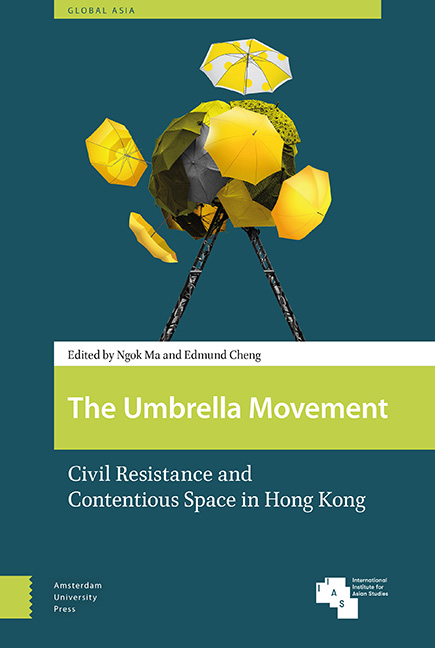Book contents
- Frontmatter
- Contents
- Acknowledgements
- Introduction: Civil Resistance and Contentious Space in Hong Kong
- Part A Trajectory and Contingency
- Part B Repertories and Strategies
- Part C Regime and Public Responses
- Part D Comparative Perspectives
- Appendix: The Umbrella Movement—Chronology of Major Events
- Index
- Publications/Global Asia
Introduction: Civil Resistance and Contentious Space in Hong Kong
Published online by Cambridge University Press: 21 November 2020
- Frontmatter
- Contents
- Acknowledgements
- Introduction: Civil Resistance and Contentious Space in Hong Kong
- Part A Trajectory and Contingency
- Part B Repertories and Strategies
- Part C Regime and Public Responses
- Part D Comparative Perspectives
- Appendix: The Umbrella Movement—Chronology of Major Events
- Index
- Publications/Global Asia
Summary
Abstract
Analysis of the 2014 Umbrella Movement speaks to three strands of academic literature: contentious politics and space, hybrid regimes and democratization, and social movements in China and Hong Kong. Based mostly on fieldwork conducted during the occupation, this book brings together 14 experts who studied the Umbrella Movement from different theoretical perspectives with different methodologies. The studies in the book analyze the occupation as a spontaneous and emotional contentious action, which made good use of public space and creative passion. They also show how civil resistance was shaped and constrained by the hybrid regime and situate the Hong Kong movement in a broader comparative perspective in reference to past student movements in China and protests in Taiwan and Macau.
Keywords: civil resistance, social movements, China, Hong Kong, hybrid regime, Umbrella Movement
For 79 days in 2014, the Umbrella Movement staged Hong Kong's most spectacular struggle for democracy and brought the city into the global spotlight. Sparked by disgruntlement over Beijing's denial of an unfettered, free chief executive election in 2017, the protest began with a class boycott and later morphed into a spontaneous, resilient street occupation of three centralized locations in the city. Roads and pavements were turned into protest sites and tent villages. The label “Umbrella Movement/Revolution” originated from a cover story in TIME Magazine, which showed protesters holding umbrellas aloft to fend off tear gas and pepper spray from the police. The protesters’ actions signified the peaceful and plebeian nature of the protest—a bottom-up and spontaneous campaign against top-down state control and power.
The Umbrella Movement was a significant episode for both new global activism and Hong Kong's political history. Even by international standards, it was a mass-scale civil disobedience movement spanning nearly three months. University polls showed that 18–20 percent of the city's population, or 1.3 to 1.45 million people, participated in the movement (CUHKCCPOS, 2014; HKUPOP, 2014). The number of protesters who participated in the Umbrella Movement is similar to other recent monumental events that brought about significant political changes, such as the 2004 Orange Revolution in Ukraine, in which 18 percent of Ukrainians participated, and the Arab Spring protests in Tunisia and Egypt, which comprised 8 and 12 percent of their respective populations (Beissinger, Jamal, and Mazur, 2012).
- Type
- Chapter
- Information
- Umbrella MovementCivil Resistance and Contentious Space in Hong Kong, pp. 11 - 24Publisher: Amsterdam University PressPrint publication year: 2019



